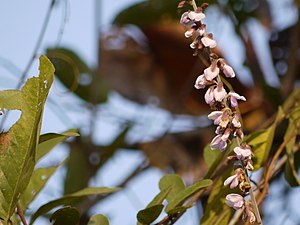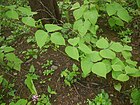Note: This is a project under development. The articles on this wiki are just being initiated and broadly incomplete. You can Help creating new pages.
Difference between revisions of "Pueraria tuberosa - Vidarikanda"
(→References) |
(→How to plant/cultivate) |
||
| Line 58: | Line 58: | ||
==How to plant/cultivate== | ==How to plant/cultivate== | ||
| − | + | It is generally propagated by seeds, but seed germination is low. Tubers and layering is also used for raising plants. Ground layering of stem is very successful for propagation. The seeds are soaked in water overnight and sown in nursery in month of May. Ground layering may be done with the help of rooting hormones. Stem cuttings also require treatment of rooting hormone. <ref name="Cultivation details"/> | |
| − | |||
| − | |||
| − | |||
| − | |||
| − | |||
| − | |||
==Commonly seen growing in areas== | ==Commonly seen growing in areas== | ||
Revision as of 12:16, 12 June 2019
Vidarikanda is a large climber with trifoliate leaves and tuberous roots. It occurs in the Himalayan tracts at low elevations and also in the hills of Central and South India.
Contents
- 1 Uses
- 2 Parts Used
- 3 Chemical Composition
- 4 Common names
- 5 Properties
- 6 Habit
- 7 Identification
- 8 List of Ayurvedic medicine in which the herb is used
- 9 Where to get the saplings
- 10 Mode of Propagation
- 11 How to plant/cultivate
- 12 Commonly seen growing in areas
- 13 Photo Gallery
- 14 References
- 15 External Links
Uses
Joint pain, Burning sensation, Improve bodymass, Skin complexion, Improve voice quality [1]
Parts Used
Chemical Composition
Common names
| Language | Common name |
|---|---|
| Kannada | bhoochakra gedde, nela gumbala balli |
| Hindi | bidarikand, bilaikand, dhodhala, ghora-bel, vidarikand |
| Malayalam | mutukku, palmutukku |
| Tamil | Nelapoosani |
| Telugu | darigummadi, |
| Marathi | NA |
| Gujarathi | NA |
| Punjabi | NA |
| Kashmiri | NA |
| Sanskrit | bhukushmandi, kandapalasah, payasvini, shrigalika, vidarikanda |
| English | Indian kudzu |
Properties
Reference: Dravya - Substance, Rasa - Taste, Guna - Qualities, Veerya - Potency, Vipaka - Post-digesion effect, Karma - Pharmacological activity, Prabhava - Therepeutics.
Dravya
Rasa
Madhura (Sweet)
Guna
Guru (heavy), Snigdha (Slimy)
Veerya
Sheeta (cold)
Vipaka
Karma
Pitta, Vata
Prabhava
Habit
Identification
Leaf
| Kind | Shape | Feature |
|---|---|---|
| Trifoliate | alternate | leaflets 5-18 x 5-12.5 cm, ovate or the terminal rhomboid, base obtuse or acute, laterals oblique at base, apex acuminate, scattered hairy above, appressed hairy beneath; lateral nerves 7 or 8 pairs, reticulations prominent; petiole to 18 cm long; stipules c. 5 mm long, ovate. Racemes axillary, 15-35 cm long; rachis silky. |
Flower
| Type | Size | Color and composition | Stamen | More information |
|---|---|---|---|---|
| Bisexual | Raceme | Bluish purple | 10 | Flowers c. 1.3 cm long, bluish-purple, ternate on the nodes of racemes; pedicels c. 3 mm long. Calyx c. 7 mm long, tomentose; tube campanulate; lobes ovate. Standard c. 1.2 cm, long, orbicular, base auricled, apex emarginate; wings c. 1.2 cm long, with spur above base; keels long-clawed. Stamens 9+1, vexillary stamen apically fused, free at base. Ovary to 8 mm long, oblong, densely brown-hirsute; style incurved; stigma capitate. |
Fruit
| Type | Size | Mass | Appearance | Seeds | More information |
|---|---|---|---|---|---|
| A Pod | 2.5-5.5 x 0.5-0.6 cm | Linear and hairy | {{{6}}} |
Other features
List of Ayurvedic medicine in which the herb is used
Where to get the saplings
Mode of Propagation
How to plant/cultivate
It is generally propagated by seeds, but seed germination is low. Tubers and layering is also used for raising plants. Ground layering of stem is very successful for propagation. The seeds are soaked in water overnight and sown in nursery in month of May. Ground layering may be done with the help of rooting hormones. Stem cuttings also require treatment of rooting hormone. [5]
Commonly seen growing in areas
Tropical area, Sub tropical area
Photo Gallery
References
- ↑ "Uses"
- ↑ "Vernacular names"
- ↑ PLANTS OF KERALA VER.2, N. Sasidharan "BOTANIC DESCRIPTION"
- ↑ "Ayurvedic preparations"
- ↑ Cite error: Invalid
<ref>tag; no text was provided for refs namedCultivation details
External Links
- Pages with reference errors
- Ayurvedic Herbs known to be helpful to treat Joint pain
- Ayurvedic Herbs known to be helpful to treat Burning sensation
- Ayurvedic Herbs known to be helpful to treat Improve bodymass
- Ayurvedic Herbs known to be helpful to treat Skin complexion
- Ayurvedic Herbs known to be helpful to treat Improve voice quality
- Herbs with Tuber used in medicine
- Herbs with common name in Kannada
- Herbs with common name in Hindi
- Herbs with common name in Malayalam
- Herbs with common name in Tamil
- Herbs with common name in Telugu
- Herbs with common name in Sanskrit
- Herbs with common name in English
- Habit - Climber
- Index of Plants which can be propagated by Seeds
- Index of Plants which can be propagated by Cuttings
- Herbs that are commonly seen in the region of Tropical area
- Herbs that are commonly seen in the region of Sub tropical area
- Herbs
- Fabaceae
- Ayurvedic herbs that don't have seed photos




